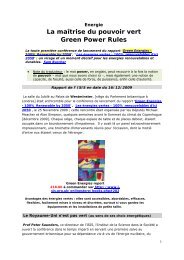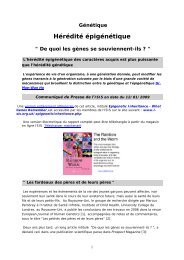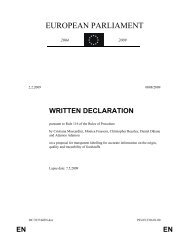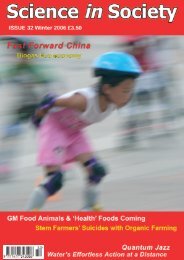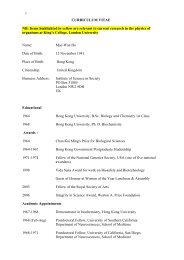Ethiopia goes organic to feed herself - The Institute of Science In ...
Ethiopia goes organic to feed herself - The Institute of Science In ...
Ethiopia goes organic to feed herself - The Institute of Science In ...
Create successful ePaper yourself
Turn your PDF publications into a flip-book with our unique Google optimized e-Paper software.
16<br />
hybrid rice Liangyoupei 9, which<br />
came both from savings and<br />
increased yield. <strong>The</strong> amount <strong>of</strong> hybrid<br />
seed needed in SRI methods was<br />
only 3 - 4.5 kg, which represented a<br />
seed saving <strong>of</strong> 8.3 - 10.5 kg and nursery<br />
saving <strong>of</strong> 90%, thereby reducing<br />
the cost by 215 Yuan/ha. As only<br />
compost was applied, the saving on<br />
the 10-12 t/ha fertilizer that would<br />
have been used was 1 200 Yuan/ha.<br />
<strong>The</strong> saving on water, some 3 000<br />
<strong>to</strong>nnes, was about 150 Yuan/ha. <strong>The</strong><br />
<strong>to</strong>tal saving with SRI methods thus<br />
amounted <strong>to</strong> about 1 565 Yuan/ha.<br />
Add <strong>to</strong> that a 15% increase in yield<br />
(1.5 <strong>to</strong>nnes/ha) and the farmer gets a<br />
<strong>to</strong>tal additional pr<strong>of</strong>it <strong>of</strong> about 3 000<br />
Yuan/ha (about US$ 360).<br />
<strong>The</strong> Sichuan Academy <strong>of</strong><br />
Agricultural <strong>Science</strong>s has done SRI<br />
trials for three years in succession. Its<br />
2003, trials showed an average SRI<br />
yield <strong>of</strong> 13 t/ha. Another series <strong>of</strong> trials<br />
in 7 regions <strong>of</strong> Zhejian Province<br />
using 8 varieties all resulted in<br />
increased yield under SRI; the average<br />
increase being 1.5 t/ha over<br />
already high-yielding controls.<br />
<strong>The</strong> China National Hybrid Rice<br />
Research and Development Centre<br />
introduced hybrid varieties in<strong>to</strong> Africa<br />
and recommended that they be used<br />
with SRI methods. <strong>In</strong> 2003, a 9.2 t/ha<br />
yield was obtained with hybrid GY032<br />
in Guinea under SRI methods, which<br />
was 4 times the national average<br />
yield.<br />
SRI in Gambia<br />
<strong>The</strong> Gambia, a small country<br />
(11700km 2 ) in West Africa, is a 50<br />
km-wide ribbon <strong>of</strong> land extending<br />
eastward from the coast, bisected by<br />
the River Gambia and surrounded on<br />
three sides by Senegal. Its annual<br />
rainfall is 900 <strong>to</strong> 1400 mm; the rainy<br />
season between late May and early<br />
Oc<strong>to</strong>ber. Rice is the staple <strong>of</strong> the<br />
country and there are 5 very different<br />
production systems: upland, lowland<br />
rainfed, irrigated (pump and tidal),<br />
freshwater swamps and seasonally<br />
saline mangrove swamp.<br />
Annual rice consumption averages<br />
70 <strong>to</strong> 110 kg per capita; domestic production<br />
lags behind by 60%, and the<br />
balance is met by imports. <strong>The</strong><br />
national average yield <strong>of</strong> rice is only 2<br />
t/ha.<br />
SRI was introduced <strong>to</strong> <strong>The</strong><br />
Gambia in the rainy season <strong>of</strong> 2000<br />
as part <strong>of</strong> the Ph. D. thesis <strong>of</strong><br />
Mustapha M. Ceesay in Crop and Soil<br />
<strong>Science</strong>s at Cornell University in the<br />
United States. Farmers were invited<br />
<strong>to</strong> visit the first SRI trial site at the<br />
Sapu station <strong>of</strong> the National<br />
Agricultural Research <strong><strong>In</strong>stitute</strong> (NARI)<br />
in <strong>The</strong> Gambia before they enrolled<br />
voluntarily in the research programme.<br />
During the first year <strong>of</strong> experimentation,<br />
three different plant population<br />
densities were investigated with several<br />
varieties. Yields ranged from 5.4<br />
<strong>to</strong> 8.3 t/ha. <strong>In</strong> 2001, plant population<br />
densities were investigated alongside<br />
fertilizer treatments, and on-farm trials<br />
involving 10 farmer households.<br />
<strong>The</strong> on-station SRI trials were conducted<br />
under pump irrigation, and onfarm<br />
trials under tidal irrigation.<br />
Plant population densities investigated<br />
were 20cm x 20cm, 30cm x<br />
30cm and 40cm x 40cm. Two rice<br />
varieties were used, and instead <strong>of</strong><br />
compost, three fertilizer treatment<br />
rates were assessed: NKP in the following<br />
proportions: 70-30-30 (national<br />
recommended), 140-30-30 and 280-<br />
30-30. All trials <strong>to</strong>ok place in the lowlands.<br />
<strong>The</strong> on-station trials indicated that<br />
30cm x 30cm spacing did not<br />
decrease yield over the 20cm x 20cm,<br />
and was hence recommended <strong>to</strong> the<br />
farmers for the on-farm trial. Fertilizer<br />
treatments indicated that under SRI,<br />
the nationally recommended lowest<br />
rate was as effective as doubling the<br />
rate, while tripling the rate gave higher<br />
yields, but it was not economically<br />
pr<strong>of</strong>itable.<br />
<strong>The</strong> on-farm trials, conducted in a<br />
communal tidal irrigation scheme,<br />
gave "exciting" results, "a tripling <strong>of</strong><br />
yield" on average, 7.4 t/ha compared<br />
with 2.5 t/ha obtained with farmers'<br />
current practices. Some farmers<br />
experienced more than five-fold<br />
increases, from 1.6 <strong>to</strong> 9.0 t/ha in one<br />
case, and 1.4 <strong>to</strong> 8.0 t/ha in another.<br />
But there are problems facing the<br />
farmers in land preparation. Farmers<br />
in <strong>The</strong> Gambia still do not have a welldeveloped<br />
culture <strong>of</strong> water control.<br />
Fields are simply kept flooded after<br />
transplanting until the rice plants<br />
mature, and fertilizer application and<br />
weeding are done under submerged<br />
conditions. <strong>The</strong>se practices will conflict<br />
with the adoption <strong>of</strong> SRI, but the<br />
yield increases may be a sufficient<br />
incentive for farmers <strong>to</strong> overcome<br />
these problems.<br />
SRI in other countries<br />
Many countries reported remarkable<br />
increases in yield. Salinda<br />
Dissanayake, Member <strong>of</strong> Parliament<br />
in Sri Lanka, personally tested SRI in<br />
his own rice field <strong>of</strong> a little more than<br />
2 acres for four seasons, using seeds<br />
<strong>of</strong> various varieties. He got the highest<br />
yield <strong>of</strong> 17 t/ha with BG358, a variety<br />
developed by the Sri Lankan rice<br />
researchers. Even with local varieties<br />
such as Rathhel and<br />
Pachdhaiperumal, usually much lower<br />
yielding at ~2 t/ha, impressive yields<br />
<strong>of</strong> 8 t/ha and 13 t/ha were obtained.<br />
Dissanayake formed a small group<br />
<strong>to</strong> inform farmers <strong>of</strong> SRI; and farmers<br />
who <strong>to</strong>ok up SRI from 18 districts<br />
have doubled their yields on average.<br />
"<strong>The</strong>se yields were obtained with<br />
less water, less seed, less chemical<br />
fertilizer, and less cost <strong>of</strong> production<br />
per kilogram …among SRI users, we<br />
find people <strong>of</strong> many different income<br />
and educational levels and different<br />
social standing, including many poor<br />
farmers having only small plots <strong>of</strong><br />
land, farmers with moderate income,<br />
some agricultural scientists, and a<br />
few administra<strong>to</strong>rs, businessmen and<br />
political leaders who practice it with<br />
their own convictions," Dissanayake<br />
said.<br />
H. M. Premaratna, a farmer from<br />
the Ecological Farming Centre,<br />
Mellawalana, Sri Lanka, backed up<br />
the enthusiasm <strong>of</strong> his Member <strong>of</strong><br />
Parliament, and has personally provided<br />
training on SRI <strong>to</strong> more than<br />
3000 farmers by 2002. "From my<br />
experience, I have observed that the<br />
rice plant becomes a healthier plant<br />
once the basic SRI practices are<br />
adopted," he said.<br />
Reports from 17 countries in 2002<br />
showed that three-quarters <strong>of</strong> the<br />
cases gave a significant yield advantage<br />
<strong>of</strong> at least 20 <strong>to</strong> 50% increase,<br />
and although the super-yields reported<br />
from Madagascar have not been<br />
obtained elsewhere, some farmers in<br />
Cambodia and Sri Lanka have come<br />
close. Overall, the conventional systems<br />
yielded 3.9 t/ha, very close <strong>to</strong><br />
the world average for rice production.<br />
<strong>The</strong> average for all the SRI yields<br />
reported was 6.8 t/ha.<br />
A report from the Philippines not<br />
only documented yield increases over<br />
several successive growing seasons<br />
since 1999, but also a reduction <strong>of</strong><br />
crop pests such as rats and brown<br />
and green leafhoppers, carriers <strong>of</strong> the<br />
dreaded rice tungro virus disease.<br />
This was attributed <strong>to</strong> the increased<br />
spacing <strong>of</strong> plants, allowing more sunlight<br />
<strong>to</strong> penetrate even the base <strong>of</strong> the<br />
plant, exposing the hoppers, which<br />
detest and avoid sunlight.<br />
<strong>In</strong> Cambodia, SRI is spreading<br />
very rapidly. Only 28 farmers were<br />
willing <strong>to</strong> try SRI in 2000, by 2003, this<br />
number had grown <strong>to</strong> almost 10 000<br />
and in 2004, 50 000 farmers are<br />
expected <strong>to</strong> adopt it.<br />
Perhaps the greatest testament<br />
that SRI works is the increasing number<br />
<strong>of</strong> farmers who have adopted the<br />
practice.<br />
SiS<br />
SCIENCE IN SOCIETY 23, AUTUMN 2004



